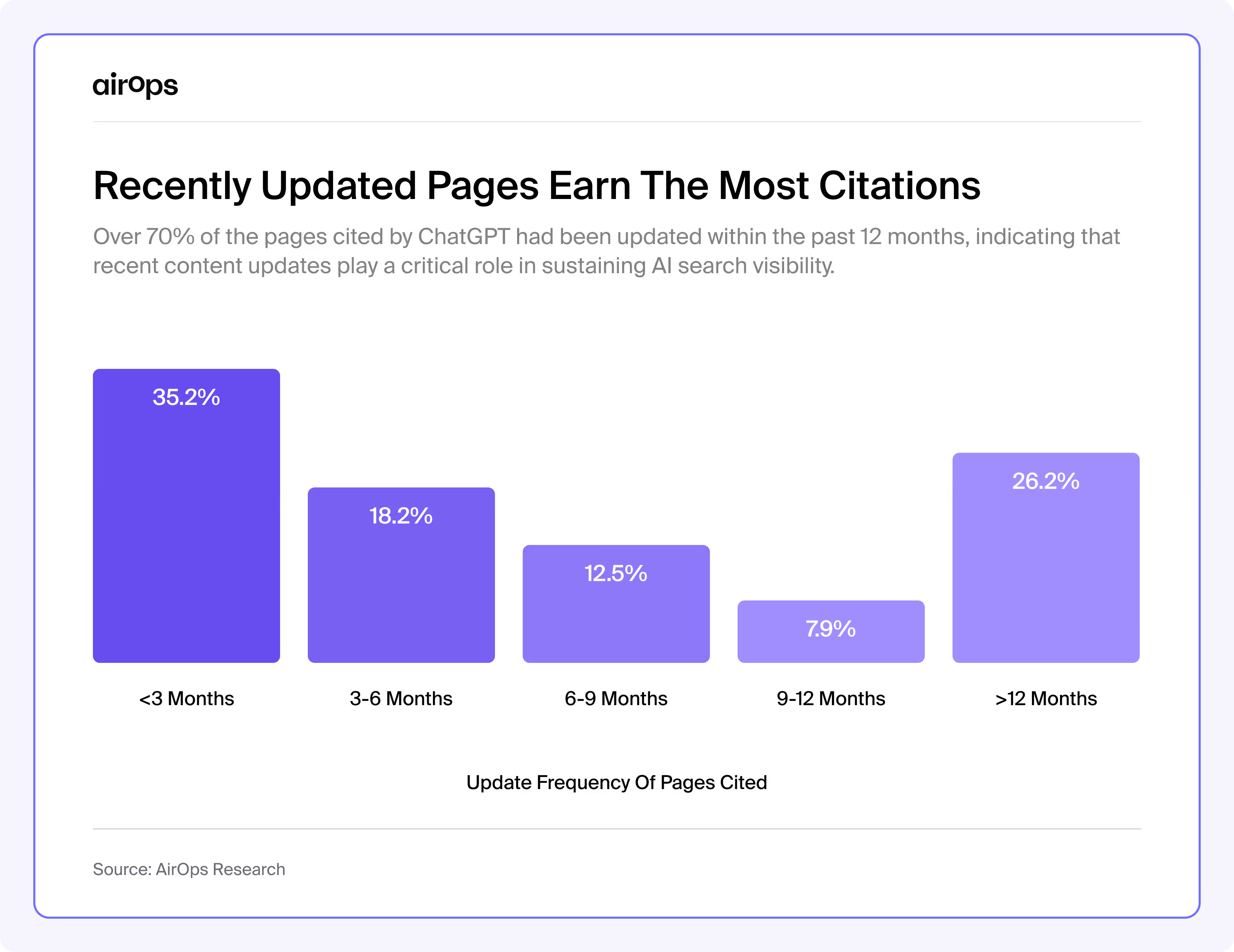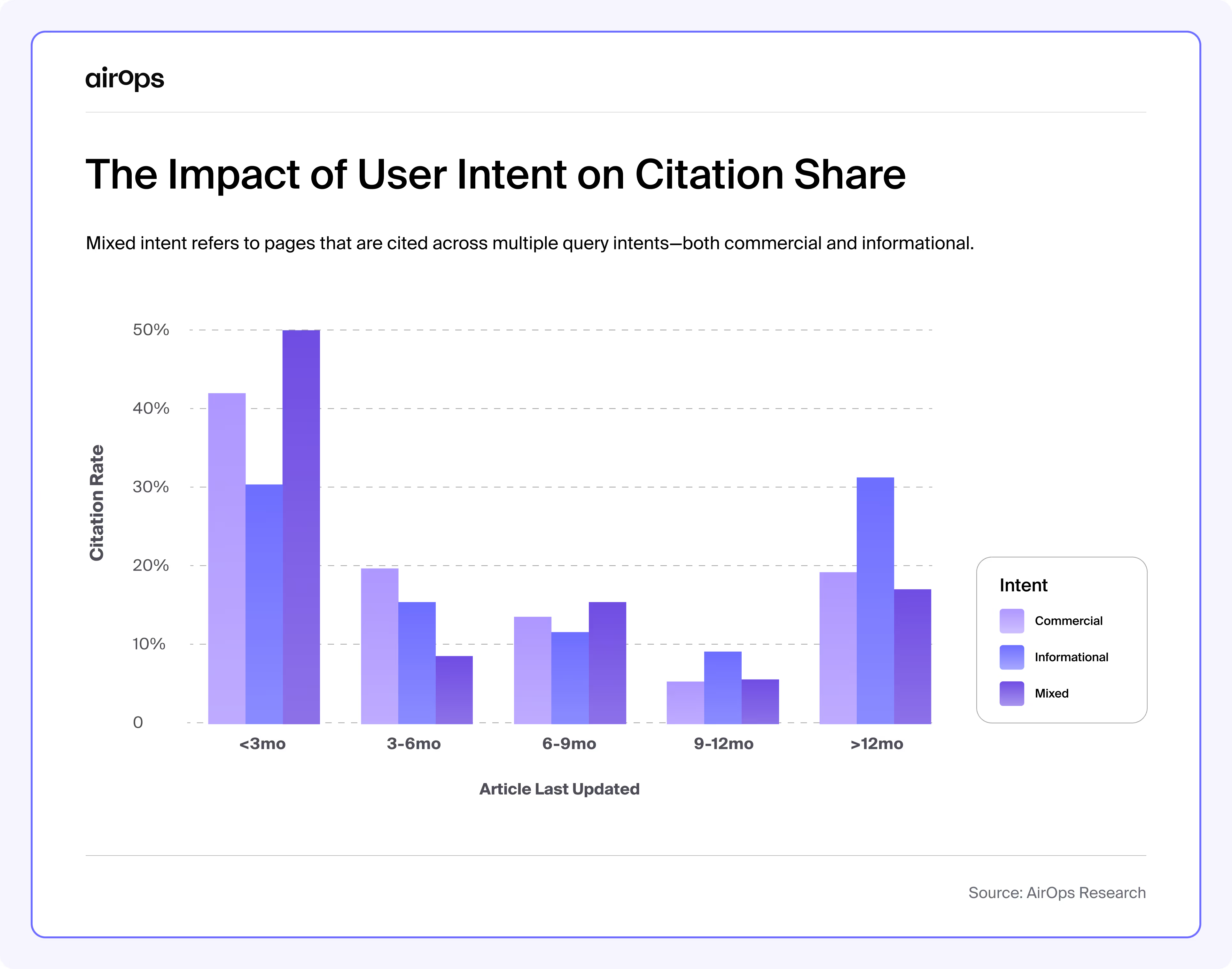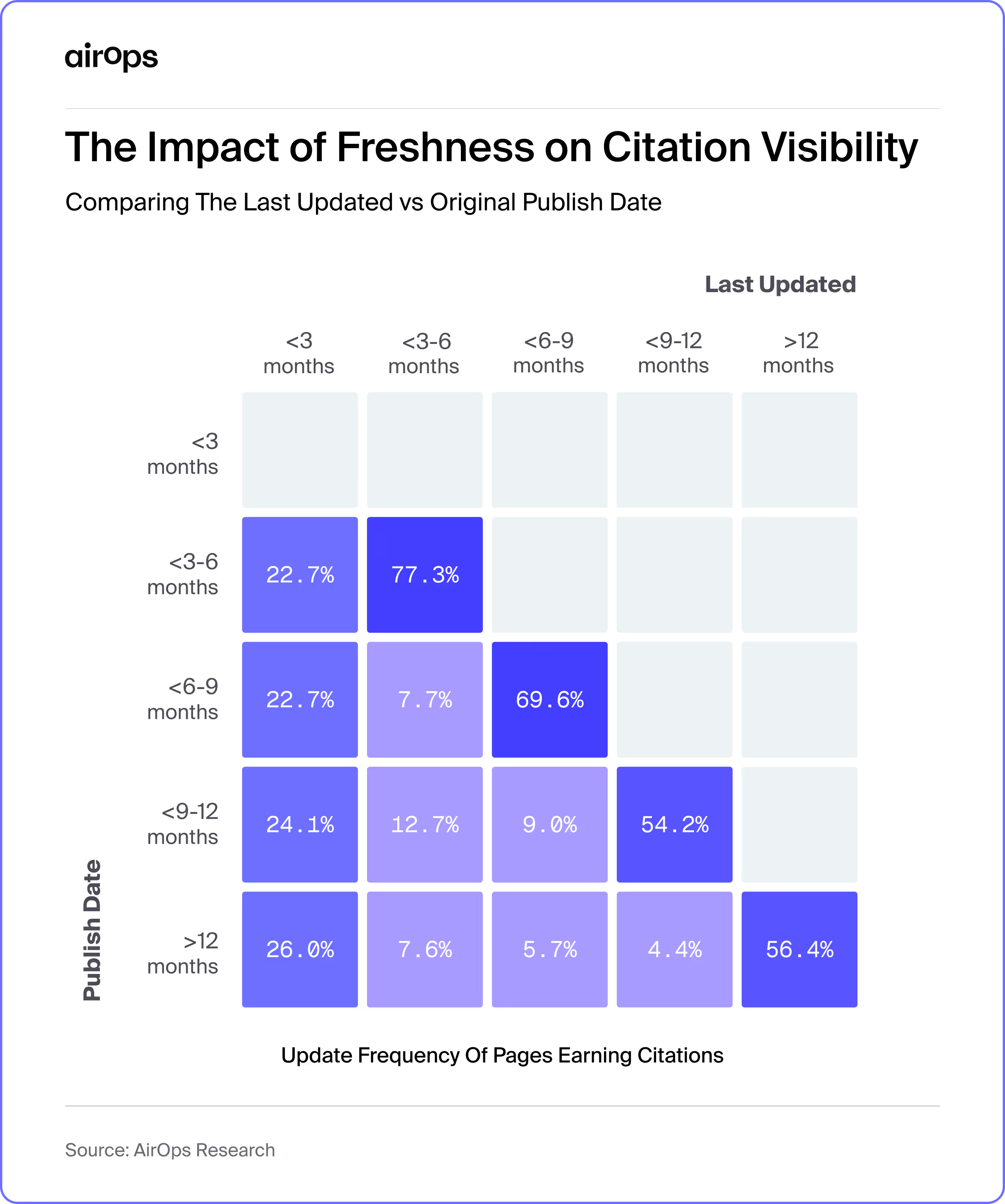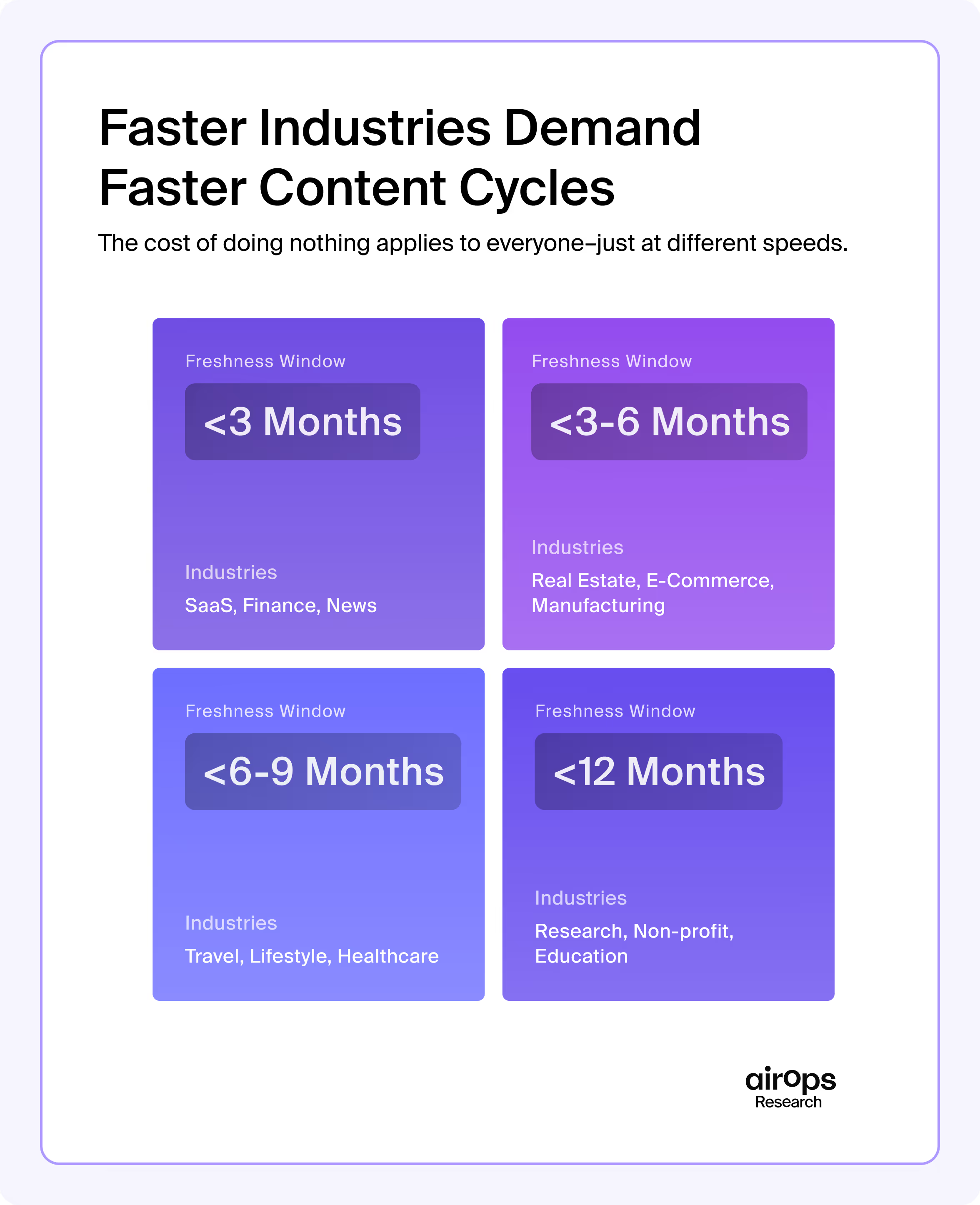The era of static, “set it and forget it” content is over.
As AI search engines like ChatGPT reshape how buyers discover, evaluate, and trust brands, freshness has become a critical battleground.
The old playbook—publishing high-quality pages and waiting for them to climb the rankings—no longer guarantees visibility.
But what actually drives sustained visibility in AI search?
Does staying current really make the difference, or is the value of content freshness overstated?
Our research set out to determine if a stale content penalty exists—and, if so, can we quantify the true cost of inaction for brands that don’t prioritize keeping content up to date?
Scope of Study
To answer these questions, we needed to determine the correlation between content freshness and AI visibility.
Our research focused on more than 4,000 pages cited by ChatGPT across 900 high-intent queries in 15 major industries. We captured key attributes like last updated date, original publish date, query intent, industry, and the content type for each citation.
By isolating these freshness signals, we set out to understand if recency directly impacts the likelihood of earning AI citations—and what that means for brands aiming to stay visible as search evolves.
The State of Content Freshness in AI Visibility
With this foundation in place, we began by looking at the overall state of content freshness among the pages earning citations in ChatGPT.
The goal was to measure how recently cited content had been updated or published—and define what “fresh” really means in the context of AI visibility.
To gauge how recent most cited content actually is, we analyzed what percentage of pages had been updated within key timeframes over the past 12 months.

Our research shows a clear and consistent link between content freshness and citation performance. Brands earning citations in ChatGPT aren’t just publishing once—they’re actively maintaining and updating their pages.
Key Insights:
- More than one-third (35.2%) of cited pages were updated in the last three months alone.
- Just over half of all (53.4%) cited pages in our dataset were refreshed within six months.
- Only about a quarter (26.2%) of all cited pages hadn’t been updated in over a year.
In short, the pages surfaced most often by AI are far from static—they’re actively maintained, highlighting a consistent trend toward recency among brands and publishers earning citations.
For brands aiming to be cited by AI, maintaining fresh, up-to-date content is no longer optional—it’s essential for ongoing visibility and relevance.
How Buying Signals Influence AI Citation Patterns
While our baseline analysis shows that refreshing content matters, we needed to determine the influence that user intent has on citation visibility.
Specifically: to what extent does the intent behind a query determine how fresh cited content needs to be?

Note: Mixed intent refers to pages that are cited across multiple query intents—both commercial and informational. These pages demonstrate high freshness, indicating their broad relevance and ability to address diverse user needs effectively.
Key Insights:
- Over 60% of commercial pages cited by ChatGPT were updated in the past six months.
- Only 1 in 5 commercial citations went to content older than a year.
- Informational queries were more likely to surface older pages, with nearly a third of cited content over a year old.
Our analysis confirms that user intent has a significant impact on content freshness. Commercial queries—those most closely tied to buying decisions and customer action—overwhelmingly surfaced recently updated content.
In contrast, informational queries showed greater tolerance for older pages.
While the pool of pages earning citations for multiple query intents is much smaller, their freshness is remarkable: 50% of mixed-intent pages cited by ChatGPT were updated within the last three months—the highest recency rate among all categories.
This pattern shows a strong link between frequent content updates and broader AI visibility.
Content that’s regularly refreshed is not only more likely to earn citations for its target query intent, but it also has a higher chance of appearing across related query types.
While freshness boosts the potential to appear for multiple intents, the degree of cross-intent visibility depends on how well the content aligns with each query’s underlying purpose.
For brands, maintaining up-to-date content significantly increases the likelihood of being found by customers, regardless of intent—provided the content is appropriately tailored to meet different search needs.
Last Updated vs. Publish Date: What Matters Most
The link between content freshness and AI citations is undeniable—and the cost of falling behind is steep.
Our analysis shows it’s not enough to publish high-quality content once. What matters most is how recently that content has been updated. AI search engines like ChatGPT prioritize recency, consistently favoring pages that reflect the latest information.
That means visibility isn’t earned at the time of publication—it’s maintained through ongoing updates.
For brands, content maintenance is no longer optional. Those that neglect refresh cycles risk fading from AI results—not because their content is bad, but because it’s outdated.

Our research shows that for content published within the past year, over 40% has been prioritized with recent updates—demonstrating that many brands actively invest in ongoing refreshes to maintain visibility and stay competitive in AI search.
Key Insights
- Ignoring freshness carries risk: 83% of citations for commercial queries—those tied to directly to customer decision-making—come from content updated within the past year.
- A significant portion of cited content is maintained through ongoing refreshes: Over a quarter (26%) of pages published more than a year ago were updated in the last three months.
- Content that is not regularly refreshed faces steep declines in AI visibility: Pages that have gone more than a year without updates see their citation likelihood drop by over 50%, underscoring the tangible cost of inaction in earning visibility in AI search.
Breaking Down The 56.4% Of Stale Content:
While 56.4% of cited pages in our dataset hadn’t been updated in over a year, the majority of these served informational queries—where buying intent is minimal or absent. In fact, 66% of this older content supports evergreen topics like best practices and how-to guides, primarily from slower-moving sectors such as Healthcare & Wellness, Personal Productivity, and Travel & Tourism.
In these verticals, content longevity remains valuable—but that window is narrowing.
Even in these traditionally slower industries, over 30% of cited Healthcare & Wellness content was refreshed in the past six months, signaling growing urgency as competition for AI visibility intensifies.
Still, these segments remains the exception—not the norm.
The majority of AI-cited content is actively maintained, underscoring that ongoing updates are the primary driver of visibility—especially for commercial queries tied to buying decisions.
Brands that don’t maintain their content aren’t just missing out—they’re actively giving up ground. As AI prioritizes recency, teams that stand still risk losing visibility, customers, and revenue to faster-moving competitors.
The Stale Content Penalty
Answer engines don’t just prefer fresh content—they penalize the stale.
Our analysis reveals a clear trend: pages that haven’t been updated in over 12 months are significantly less likely to earn citations from ChatGPT.
This decline in visibility isn’t random—it’s the result of what we call the stale content penalty.
Search engines are evolving quickly, and outdated content is quietly but consistently deprioritized in AI-generated answers.
Quantifying the Penalty
- Ignoring freshness carries significant risk: Pages that haven’t been updated within the past year are more than twice as unlikely to be cited by ChatGPT.
- The stale content penalty intensifies in fast-moving industries: In sectors like SaaS, Finance, and News, the “freshness window” narrows to as little as 3 months.
- This penalty is especially severe for commercial queries: Pages not refreshed annually lose over 50% of their chance to be cited.

Understanding the Freshness Window
The freshness window—the timeframe within which content must be updated to stay competitive in AI citations—varies significantly by industry and user intent.
During our research, we dug deeper into these dynamics to understand how update frequency aligns with different sectors and query types.
Key Insights:
- In fast-moving industries like SaaS, Finance, and News, the freshness window is narrow—content must be updated every <3 months to maintain competitive visibility.
- In slower-moving verticals, such as Education or Research, evergreen content can remain relevant for 12 months or more before updates become necessary.
- User intent also shapes the freshness window–commercial queries tied to buying decisions demand fresher content, while content thats optimized for informational intent may tolerate a longer shelf life.
- Brands that align their content refresh cadence with their industry’s freshness window are better positioned to sustain AI citations and stay ahead of competitors.
Ignoring content maintenance isn’t just a missed opportunity—it’s a direct path to declining AI visibility and traffic.
As AI search engines continuously evolve, brands that fail to refresh risk losing their competitive foothold, while those who prioritize freshness continue to gain authority and capture market share.
Content Maintenance is Non-Negotiable
Our analysis shows that over 70% of pages earning citations and visibility in ChatGPT were updated within the past 12 months.
ChatGPT and other LLMs rapidly shift citations to the freshest, most up-to-date sources—especially in commercial and fast-moving industries.
Even authoritative, high-quality content loses ground without frequent updates.
To meet these demands, content teams must move beyond periodic refreshes and adopt more efficient, scalable update processes.
The Bottlenecks Content Teams Face
The challenge? Teams still relying on manual workflows are quietly getting outranked by those moving faster.
While the need for content maintenance is clear, most teams are still stuck with outdated processes that drain time, slow execution, and limit how much they can actually refresh.
Without a scalable system in place, even high-priority pages fall behind—costing teams visibility when it matters most.
When it comes to content maintenance, brands face three options:
A) Do nothing—and risk falling victim to the stale content penalty
B) Rely on slow, manual reviews—burning valuable time and resources
C) Build structured AI workflows—to scale optimization, streamline updates, and ensure quality without bottlenecks
The longer teams delay, the more visibility they lose. Stale pages don’t just stop performing—they actively lose citations and compound negative ROI, especially in high-competition markets.
AirOps gives content teams a smarter way to scale.
By centralizing refresh workflows and enabling AI-assisted updates with human-in-the-loop control, AirOps help teams break through the bottlenecks—and win in both traditional and AI-powered search.
Book a strategy session to learn how AirOps can help your team stay current, cited, and ahead of the competition.

